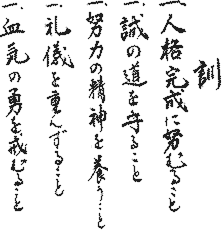Gichin Funakoshi (1868 – 1957)

Today, karate is a martial art practiced not only in Japan but all over the world. Before Gichin Funakoshi, karate was only a regional art of Okinawa and was transmitted from masters to their followers personally.
Funakoshi’s story is very similar to that of many greats in karate. He began as a weakling, sickly and in poor health, whose parents brought him to Itosu for his karte training. Between his doctor, Tokashiki, who prescribed certain herbs that would strengthen him, and Itosu’s good instruction, Funakoshi soon blossomed. He became a good student, and with Asato, Arakaki and Matsumura as his other teachers, expertise and his highly disciplined mind.
When he finally came to Japan from Okinawa in 1922, he stayed among his own people at the prefectural students’s dormitory at Suidobata, Tokyo. He lived in a small room alongside the entrance and would clean the dormitory during the day when the students were in their classes. At night, he would teach them karate.
When the Yashiro Fleet visited Okinawa from the main islands of Japan, selected sailors practiced karate under the direction of Gichin. Since the art was so powerful, the Navy decided to not adopt the art.
In March 1921, when Emperor Hirohito was still the Crown Prince, he visited Okinawa en-route to a visit to Europe. Gichin Funakoshi led a public performance of karate, which was performed by selected students at the Grand Hall of Shuri Castle, in front of the Crown Prince.
In May 1922, Gichin attended the First Budo and Physical Education Exhibition sponsored by the Ministry of Education at the request of the Department of Education of Okinawa Prefecture, and demonstrated Okinawa’s art of self defence “karate”. This was the first performance in the main islands of Japan where Gichin demonstrated.
In 1924, he changed the name “ (Chinese hands)” to “ (empty hands) and “karate-jutsu (karate techniques)” to “karate-do (karate way)”.

Shotokan Nijukun

Gichin wrote the twenty lessons of karate to show the attitudes that people must have to learn karate and the philosophy of life for karate trainees:
-
Karate is not only dojo training.
-
Don’t forget that Karate begins with a bow and ends with a bow.
-
In Karate, never attack first.
-
One who practices Karate must follow the way of justice
-
First you must know yourself. Then you can know others.
-
Spiritual development is paramount; technical skills are merely means to the end.
-
You must release your mind
-
Misfortune comes out of laziness.
-
Karate is a lifelong training.
-
Put Karate into everything you do.
-
Karate is like hot water. If you do not give heat constantly it will again become cold.
-
Do not think you have to win. Think that you do not have to lose.
-
Victory depends on your ability to tell vulnerable points from invulnerable ones.
-
Move according to your opponent.
-
Consider your opponent’s hands and legs as you would sharp swords.
-
When you leave home, think that millions of opponents are waiting for you.
-
Ready position for beginners and natural position for advanced students.
-
Kata is one thing. Engaging in a real fight is another.
-
Do not forget (1)strength and weakness of power, (2)expansion and contraction of the body, (3)slowness and speed of techniques.
-
Devise at all times.
In 1936, Gichin changed the name “Dai-nihon Karate-do Kenkyukai”, which was established to promote communication and information exchange among people who study karate-do, to “Dai-nihon Karate-do Shoto-kai”. “Shoto” was the pen name of Gichin.
In 1939, Gichin constructed a karate dojo “Dai-nihon Karate-do Shoto-kan” in Zoshigaya, Mejiro, with the co-operation of Gigo Funakoshi and other followers. Shoto-kan played the central role in the technical aspects as the main dojo of Dai-nihon Karate-do Shoto-kai, and established the systematic daily exercises, which are generally practiced today. Gichin invented Taikyoku no kata, kumite ten-no kata, and kon no kata “matsukaze”.
In the air raids of World War II, the Shotokan dojo was destroyed, and the growth of karate came to a halt. But after the war, followers of Funakoshi’s way re-grouped, and in 1949 they formed the Japan Karate Association, with Funakoshi Gichin as Supreme Master.
On April 10, 1957, the Ministry of Education gave official recognition to the JKA, and it became a legal entity. Sixteen days later, aged 89, Master Funakoshi passed away. A large public memorial service was held at the Ryogoku Kokugikan (Ryogoku National Sumo Hall), attended by more than 20,000 people, including many famous names who came to pay their respects.
Shotokan DojoKun
What does that mean?
Read the words from the top down and from right to left. The right-most character says “Kun.” Every line begins with a counter that means “one.” Every line ends with the word koto, which literally means “thing.” This is generally interpreted to mean “Here’s a rule, here’s another rule…”
-
Hitotsu. Jinkaku kansei ni tsutomuru koto
-
Hitotsu. Makoto no michi wo mamoru koto
-
Hitotsu. Doryoku no Seishin wo yashinau koto
-
Hitotsu. Reigi wo omonzuru koto
-
Hitotsu. Kekki no yu wo imashimuru koto
-
First. Seek perfection of character
-
First. Protect the way of the truth
-
First. Foster the spirit of effort
-
First. Respect the principles of etiquette and respect others
-
First. Guard against impetuous courage and refrain from violent behavior.
What is the purpose of having a dojokun?
The purpose of the Dojo Kun is to lend some ethical justification for the practice of Karate, and to guide children who practice Karate in the proper use of their skills. Essentially the dojokun is a type of motto to say that you agree not to misuse your skills etc. You agree to try hard in class, attempt to better yourself and others, and behave the way that is expected of you.

